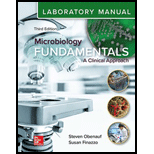
Laboratory Manual for Microbiology Fundamentals: A Clinical Approach
3rd Edition
ISBN: 9781260163469
Author: OBENAUF, Steven
Publisher: MCGRAW-HILL HIGHER EDUCATION
expand_more
expand_more
format_list_bulleted
Question
Chapter 22, Problem 20Q
Summary Introduction
To determine:
Whether the statement “the environment would be safer place for human health if all microbes could be eliminated from it” is valid or not.
Introduction:
Microbes are the small living things that are not visible with naked eyes. The microbes are present everywhere (air, water, soil). In the environment, both harmful and beneficial microbes are present. Not all microbes are harmful for humans, but some are also beneficial for humans.
Expert Solution & Answer
Want to see the full answer?
Check out a sample textbook solution
Students have asked these similar questions
What is the structure and function of Eukaryotic cells, including their organelles? How are Eukaryotic cells different than Prokaryotic cells, in terms of evolution which form of the cell might have came first? How do Eukaryotic cells become malignant (cancerous)?
What are the roles of DNA and proteins inside of the cell? What are the building blocks or molecular components of the DNA and proteins? How are proteins produced within the cell? What connection is there between DNA, proteins, and the cell cycle? What is the relationship between DNA, proteins, and Cancer?
Why cells go through various types of cell division and how eukaryotic cells control cell growth through the cell cycle control system?
Chapter 22 Solutions
Laboratory Manual for Microbiology Fundamentals: A Clinical Approach
Ch. 22.1 - Draw your own representation or logo depicting how...Ch. 22.2 - Provide a definition for zoonosis.Ch. 22.2 - Discuss the effects of deforestation and...Ch. 22.3 - Differentiate between coliforms and E. coli.Ch. 22.3 - Prob. 5AYPCh. 22.3 - Prob. 1MMCh. 22.3 - Q. What further precautions can vulnerable people...Ch. 22.4 - Define biological oxygen demand.Ch. 22.4 - Prob. 7AYPCh. 22.4 - Prob. 8AYP
Ch. 22 - Prob. 1QCh. 22 - In Malaysia, a form of malaria that was previously...Ch. 22 - Prob. 3QCh. 22 - Prob. 4QCh. 22 - Why do you think microbes are so adept at breaking...Ch. 22 - Prob. 6QCh. 22 - Contaminated water has a. lower biological oxygen...Ch. 22 - Why do microbes exist that are capable of cleaning...Ch. 22 - Prob. 9QCh. 22 - Prob. 10QCh. 22 - Prob. 11QCh. 22 - With what you have learned about increasingly...Ch. 22 - Prob. 13QCh. 22 - Explain how a warming climate is likely to impact...Ch. 22 - Conduct research to find out where the...Ch. 22 - Prob. 16QCh. 22 - Prob. 17QCh. 22 - Zika virus infection in adults may be asymptomatic...Ch. 22 - Prob. 19QCh. 22 - Prob. 20QCh. 22 - Prob. 21QCh. 22 - Prob. 1VC
Knowledge Booster
Learn more about
Need a deep-dive on the concept behind this application? Look no further. Learn more about this topic, biology and related others by exploring similar questions and additional content below.Similar questions
- In one paragraph show how atoms and they're structure are related to the structure of dna and proteins. Talk about what atoms are. what they're made of, why chemical bonding is important to DNA?arrow_forwardWhat are the structure and properties of atoms and chemical bonds (especially how they relate to DNA and proteins).arrow_forwardThe Sentinel Cell: Nature’s Answer to Cancer?arrow_forward
- Molecular Biology Question You are working to characterize a novel protein in mice. Analysis shows that high levels of the primary transcript that codes for this protein are found in tissue from the brain, muscle, liver, and pancreas. However, an antibody that recognizes the C-terminal portion of the protein indicates that the protein is present in brain, muscle, and liver, but not in the pancreas. What is the most likely explanation for this result?arrow_forwardMolecular Biology Explain/discuss how “slow stop” and “quick/fast stop” mutants wereused to identify different protein involved in DNA replication in E. coli.arrow_forwardMolecular Biology Question A gene that codes for a protein was removed from a eukaryotic cell and inserted into a prokaryotic cell. Although the gene was successfully transcribed and translated, it produced a different protein than it produced in the eukaryotic cell. What is the most likely explanation?arrow_forward
- Molecular Biology LIST three characteristics of origins of replicationarrow_forwardMolecular Biology Question Please help. Thank you For E coli DNA polymerase III, give the structure and function of the b-clamp sub-complex. Describe how the structure of this sub-complex is important for it’s function.arrow_forwardMolecular Biology LIST three characteristics of DNA Polymerasesarrow_forward
arrow_back_ios
SEE MORE QUESTIONS
arrow_forward_ios
Recommended textbooks for you
- Basic Clinical Lab Competencies for Respiratory C...NursingISBN:9781285244662Author:WhitePublisher:Cengage
 Comprehensive Medical Assisting: Administrative a...NursingISBN:9781305964792Author:Wilburta Q. Lindh, Carol D. Tamparo, Barbara M. Dahl, Julie Morris, Cindy CorreaPublisher:Cengage Learning
Comprehensive Medical Assisting: Administrative a...NursingISBN:9781305964792Author:Wilburta Q. Lindh, Carol D. Tamparo, Barbara M. Dahl, Julie Morris, Cindy CorreaPublisher:Cengage Learning

Basic Clinical Lab Competencies for Respiratory C...
Nursing
ISBN:9781285244662
Author:White
Publisher:Cengage




Comprehensive Medical Assisting: Administrative a...
Nursing
ISBN:9781305964792
Author:Wilburta Q. Lindh, Carol D. Tamparo, Barbara M. Dahl, Julie Morris, Cindy Correa
Publisher:Cengage Learning

Bacterial Infections in Humans; Author: Professor Dave Explains;https://www.youtube.com/watch?v=FeFKAl9KyMg;License: Standard Youtube License